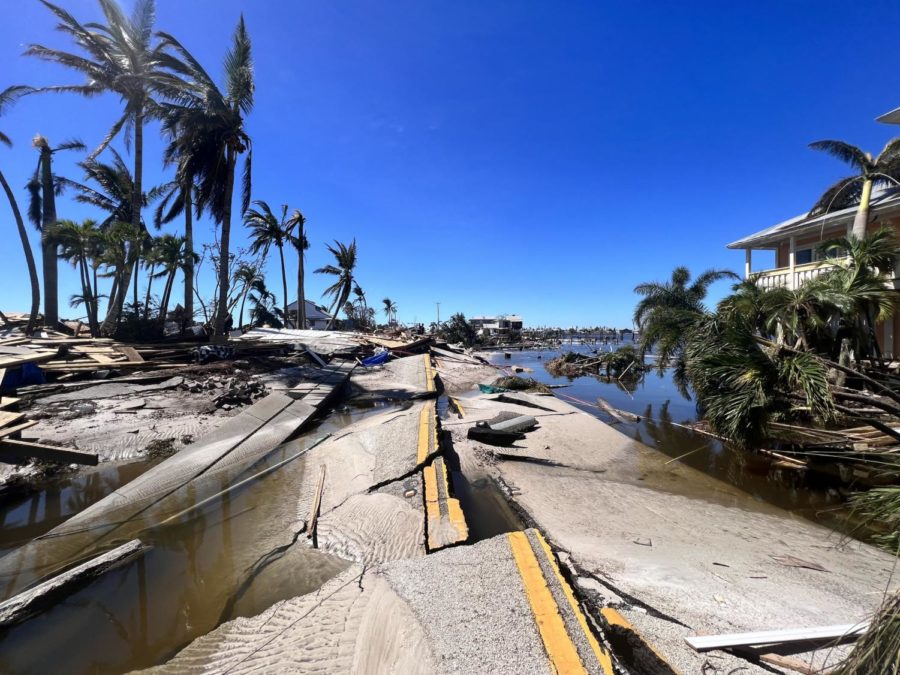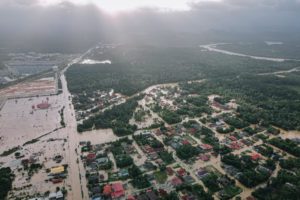Hurricane Ian wreaks havoc across Florida, disrupting the lives of many
Florida Fish and Wildlife
Hurricane Ian causes destruction of the Florida coast, disrupting the lives of many.
November 19, 2022
On Sept. 28, 2022, Hurricane Ian was one of the deadliest hurricanes to strike the United States since the 1930s. With its three separate landfalls in Cuba, Florida and South Carolina, the tropical cyclone claimed the lives of more than 108 citizens.
With its first landfall in Cuba, officials assumed that the storm would die down as it made its way to Florida. Much to their surprise, the storm picked up energy and became classified as a Category 4 hurricane as it made its landfall in Cayo Costa, Fl.
According to InsideClimate, the unseasonably warm waters of the Atlantic Ocean supercharged Hurricane Ian storm surge intensity as it made landfall.
“Evaporation intensifies as temperatures rise, and so does the transfer of heat from the oceans to the air. As the storms travel across warm oceans, they pull in more water vapor and heat. That means stronger wind, heavier rainfall and more flooding when the storms hit land.” said the Environmental Defense Fund (EDF) organization.
Ian brought severe rainfall and winds of 150 mph, leading to catastrophic flooding across Florida. Areas along the Florida coast have seen flooding ranging from 2-12 feet.
Craig Fugate, a former administrator of FEMA and Florida’s former director of the Emergency Management Division, said on WLRN radio, “This was probably the largest area of storm surge damage that we’ve seen in history.”
The storm surge for Hurricane Ian was at a catastrophic 12 to 16 feet causing major and record river flooding across central Florida, “People look at the images and say ‘that was wind.’ No, it was a storm surge. That’s the power of water.”
The first attribution study done by the National Weather Service found that climate change infused the hurricane with 10 percent more rain.
Adding on to that, a report done by NASA concluded that “Hurricane Ian was considerably larger than [past hurricanes] and moved much slower. This means that structures were subjected to high winds and storm surge for considerably longer during Ian.”
Ian’s unexpected climb in categories led to Florida’s Governor Ron DeSantis placing more than 2.5 million evacuation orders, along with opening at least 100 evacuation centers for the public before the landfall as an attempt to minimize damage.
Despite the warnings issued by the state government, many refused to leave the comfort of their homes and decided to brave the face of danger. Lock Browne, a resident of Florida and a victim of Hurricane Ian’s damage was included in this endeavor.
Browne and his family decided to stay behind despite the evacuation order since they thought their area wouldn’t be affected as much, though they did prepare for the hit.
“We boarded up all the windows and sealed all the doors and spent the whole duration of the hurricane making sure water wouldn’t come in,” explained Browne.
Browne’s valiant efforts to stop water from flooding his house succeeded, however, the same could not be said for the surrounding houses as they all were flooded with at least two feet of water.
“In some areas of the neighborhood the flooding was so bad you couldn’t get a car through, and that was pretty much our entire block. So we were stuck for three days in our house without water or electricity before we could go out,” said Browne.
Like Browne, around 2.7 million people suffered from power outages, which affected approximately 25% of the state in total. Browne and his family were included in these numbers.
As a result, FEMA has dedicated $420 million to Florida’s recovery process, along with the $30 million that Gov. DeSantis hopes to get from the Dislocated Worker Grant Program to bring Florida back to its original, pre-Ian state. This program will help provide temporary jobs to those who were impacted by the hurricane and to businesses that have helped out their employees.
In addition to advancing the recovery of the state, the Florida Disaster Fund has been receiving continuous donations from around the nation that have now accumulated to over $40 million since its activation on Sept. 28.
First Lady Casey Desantis spotlighted the efforts, “100 percent of the funds that we raise go directly to the relief efforts … We have had 62,000 people from across Florida and the nation that have donated and we have had some really great businesses that have made sizable donations, which has been wonderful.”
Various companies are also chipping in to aid storm victims. 52 corporations, such as Microsoft and Goldman Sachs, have contributed to the Fund. The money is already in use at “ground zero of Ian’s wreckage.” Telecommunications companies such as T-Mobile, Verizon and AT&T, are supporting people by providing unlimited talk, text and data in affected areas to help them stay connected. For those who are in need of evacuation, hospitality companies are helping people make emergency accommodations.
Hurricane Ian did not just limit itself to destroying the Florida peninsula, it also took a toll on the mental health of many Floridians. In a CBS Miami article, Joe Kuckzo, a Florida resident who endured the storm in his trailer said, “Every time I hear the wind blow and a piece of a wind aluminum shift, it’s kind of like PTSD.”
In a study done by the NIH, 1637 Florida residents were surveyed for psychological effects after repeated exposure from hurricanes. The researchers found that after being exposed to Hurricane Irma and Michael directly or indirectly, they developed psychological symptoms that could lead them to have increased mental health risks.
To combat this, the Florida Department of Health and the Department of Children and Families have partnered with BetterHelp, an online platform designed to offer mental health services, to provide three months of free online therapy for those who were impacted. In addition, First Lady Casey Desantis worked with Sara Newhouse, the State Disaster Recovery Mental Health Coordinator, to build a mental health resource webpage to help first responders access the resources when needed.
The aftermath of the floods in Florida has led to the arrival of flesh-eating bacteria. The flesh-eating bacteria, also known as Vibrio vulnificus, live in warm seawater and their infections start when they come in contact with open wounds or cuts with warm, salty water.
According to the state’s health department, there has been a reported number of 65 infection cases, which is the first time the amount has risen above 50 since 2008, and 11 deaths from the bacteria. They have advised Floridians who have any cuts or scrapes to not enter the water as it could cause mild to severe health concerns.
Now as Florida is in a state of recovery, they work to rebuild the damages that left many in distress.





